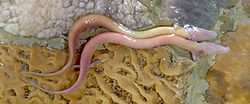Olm facts for kids
Quick facts for kids Olm |
|
|---|---|
 |
|
| Olms in Postojna Cave, Slovenia | |
| Scientific classification | |
| Kingdom: | |
| Phylum: | |
| Class: | |
| Subclass: | |
| Order: | |
| Family: | |
| Genus: |
Proteus
|
| Species: |
P. anguinus
|
| Binomial name | |
| Proteus anguinus Laurenti, 1768
|
|
| Subspecies | |
Laurenti, 1768
Sket & Arntzen, 1994 |
|
The olm or proteus (Proteus anguinus) is a unique salamander that lives only in water. It's the only animal in Europe that spends its entire life deep inside caves. Unlike most amphibians, which can live on land and in water, the olm is fully aquatic. This means it eats, sleeps, and even has its babies underwater!
You can find olms in the underground waters of the Dinaric Alps. This mountain range stretches across Central and Southeastern Europe. Specifically, they live in the limestone caves of southern Slovenia, parts of Italy near Trieste, southwestern Croatia, and Bosnia and Herzegovina. Some olms have also been introduced to new areas near Vicenza, Italy, and Kranj, Slovenia.
Local people sometimes call the olm the "human fish" because its skin is a pale, fleshy color. It's also known as the "cave salamander" or "white salamander." In Slovenia, its local name is močeril.
The olm was first mentioned in a book in 1689 by a local expert named Valvasor. He wrote that after heavy rains, olms would be washed out of the underground waters. People back then thought these strange creatures were baby dragons!
This amazing cave salamander is famous for how it has adapted to living in complete darkness underground.
Contents
Amazing Adaptations
The olm has some incredible features that help it survive in its dark, watery home.
Sensory Superpowers
The olm's eyes are not developed, so it cannot see. It is completely blind! But don't worry, its other senses are super strong. Its sense of smell and hearing are incredibly sharp. This helps it find food and navigate in the dark.
The front part of the olm's head has special sensors. These help it detect chemicals, movements, and even tiny electrical signals in the water. This is like having built-in sonar and a super nose!
Unique Appearance
The olm's skin has no pigmentation, which is why it looks pale or white. This is because it doesn't need protection from the sun's rays underground.
It has three toes on its front legs, but only two toes on its back legs. This is a bit unusual for a salamander.
Staying Young: Neoteny
The olm also shows something called neoteny. This means it keeps some of its baby (larval) features even when it becomes an adult. For example, it keeps its feathery external gills, which are bright red. Other amphibians, like the axolotl and mudpuppies in America, also show this trait.
Species and Family
The olm is the only species in its genus called Proteus. It's also the only European species in the family Proteidae. The only other living genus in this family is Necturus, which includes the mudpuppies found in North America.
Images for kids
-
The olm as depicted by the French biologist Gaston Bonnier in 1907
-
The research vent-hole in Jelševnik near Črnomelj, where quality checks of water and sediments are performed regularly, and where activities of black olms are registered with an IR camera
See also
 In Spanish: Proteus anguinus para niños
In Spanish: Proteus anguinus para niños







